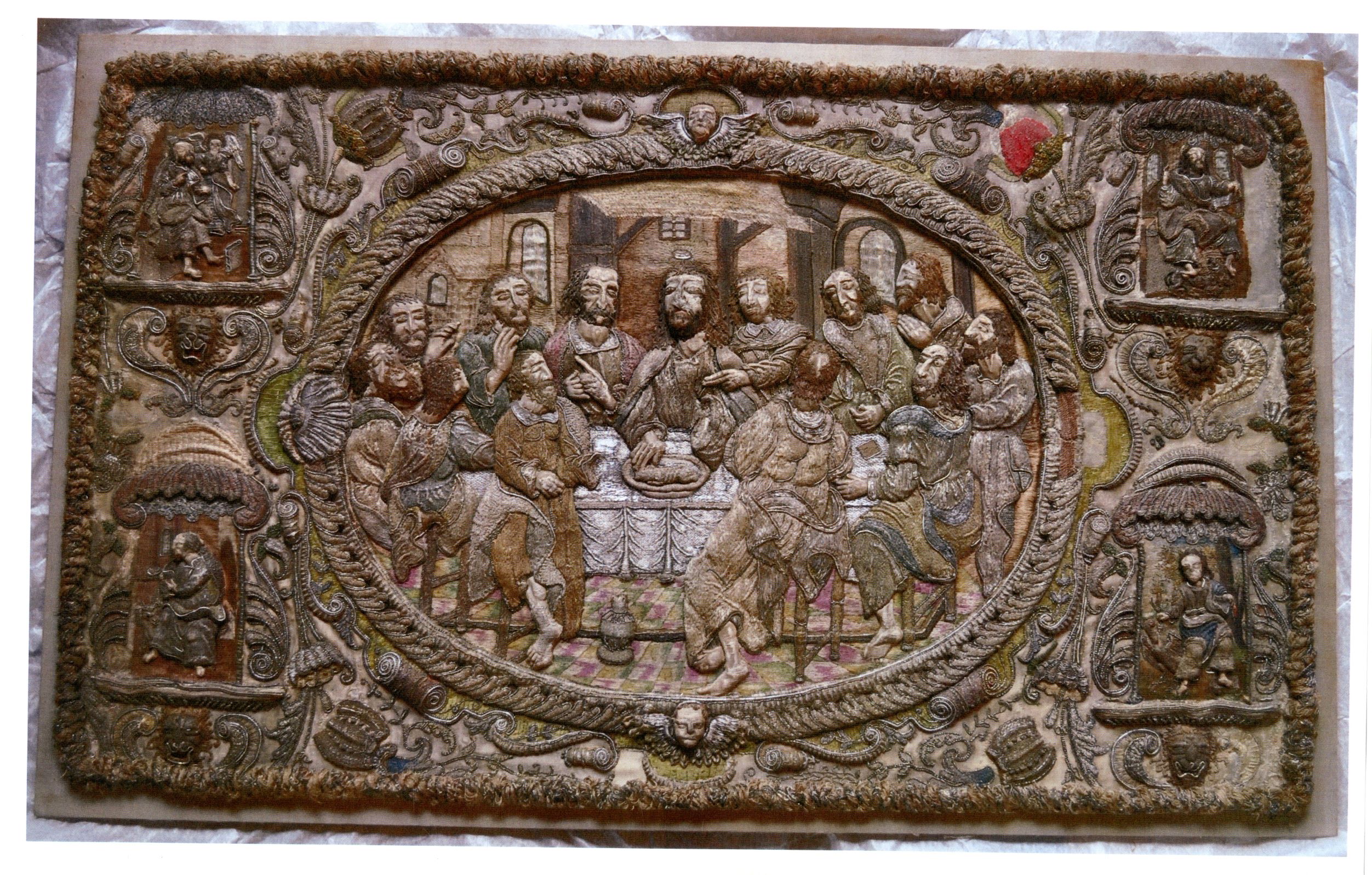
Stumpwork Panel of the Last Supper [TA4]
England, 1636
Silk with gold and silver thread (H. 58m, W. 96cm)
This embroidered panel originally covered a cushion on the altar in College chapel. It is first recorded in an inventory dated September 1636 and described as ‘A new Cushion for ye Communion table, wherein is a description of Christ eating ye Passover with his 12 Apostles’. The Bursars’ accounts for 1636-37 record payments to a ‘Mr Cheevers’ for a cushion ‘for the Holy Table’ (£14 and 18 shillings for materials and £10 for labour). A separate entry in the previous year’s accounts records the purchase of 9lbs of feathers along with gold, silver and silk thread (at a total cost of £5 and 14 shillings). It is likely, but not certain, that those materials were also used in making the cushion. The sums involved are considerable, the equivalent of several years’ wages for an ordinary labourer.
The embroidery technique used in this panel is known as stumpwork. It is characterised by the use of raised elements, stitched over a wire framework, to create a three-dimensional effect. Stumpwork was especially popular in England in the second half of the 17th century, and this panel was once thought to date from the 1670s-80s. The archival records show that it is instead one of the earliest English examples of the technique. It was commissioned as part of a refurnishing of the College chapel in the 1630s, which included the erection of a wooden altar rail and the purchase of a pulpit cloth. These changes followed a visitation by Archbishop William Laud. Among his injunctions to the College was the instruction: ‘that your chapel be from time to time kept in good repair, the ornaments therein made seemly, your Communion table comely, and decently adorned’. The changes made at Winchester are consistent with Laud’s concern for the beauty and dignity of church interiors. The 1630s also saw the widespread reintroduction of Biblical imagery to churches, and a reassertion of the importance of the Eucharist in worship and theology. This panel, with its detailed representation of the Last Supper, is characteristic of the sacred art of the period.
In 1644, the stumpwork was removed from the cushion on the altar and replaced with a plain satin cover. This alteration is recorded in the annual inventory of chapel goods, and the Bursars’ accounts show that Mr Cheevers was paid one shilling and sixpence for the work. It coincided with the fall of Winchester to the parliamentarians, two years after the outbreak of the English Civil War. As the city came under Parliamentary control, the furnishings of Chapel were made to conform to the plainer tastes of the Puritans.
Having been removed from its cushion, the embroidery was stored for several decades in the Warden’s Lodgings where the annual inventories record various items of ‘old Church stuffe’. In 1674-5, it was transferred to Election Chamber and described as ‘an embroydered Altarpeece’. In 1683, the panel was returned to Chapel and served again as the cover of a cushion on the altar. This followed an extensive reordering of the Chapel interior by Warden Nicholas, who provided wooden panelling, marble paving, altar rails and a screen. By the late 17th century, richly decorated church interiors, and religious images, had once again become acceptable in the Church of England.
The cushion was last recorded in Chapel in 1832. By the beginning of the 20th century the stumpwork panel had once again been detached. It was restored by the Victoria and Albert Museum in 1902, and framed behind glass.
Literature: Country Life, Vol. XI, no. 267 (15 February 1902), pp. 201-202; Patricia Wardle, ‘A Laudian Embroidery’, V&A Bulletin, Vol. 1, No. 1 (January 1965); Patricia Wardle, ‘English Pictorial Embroidery of the 17th Century’, in Peter Wilson (ed.), Antiques International (London, 1966), p. 286.
Provenance: Commissioned by Winchester College
Location: Chapel